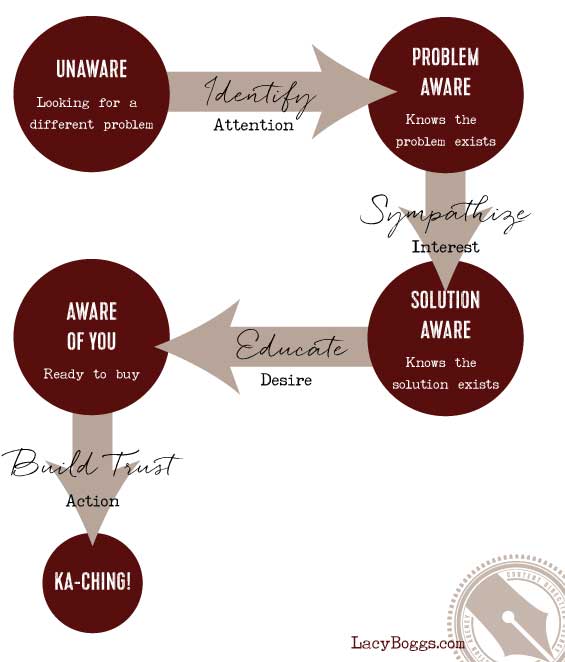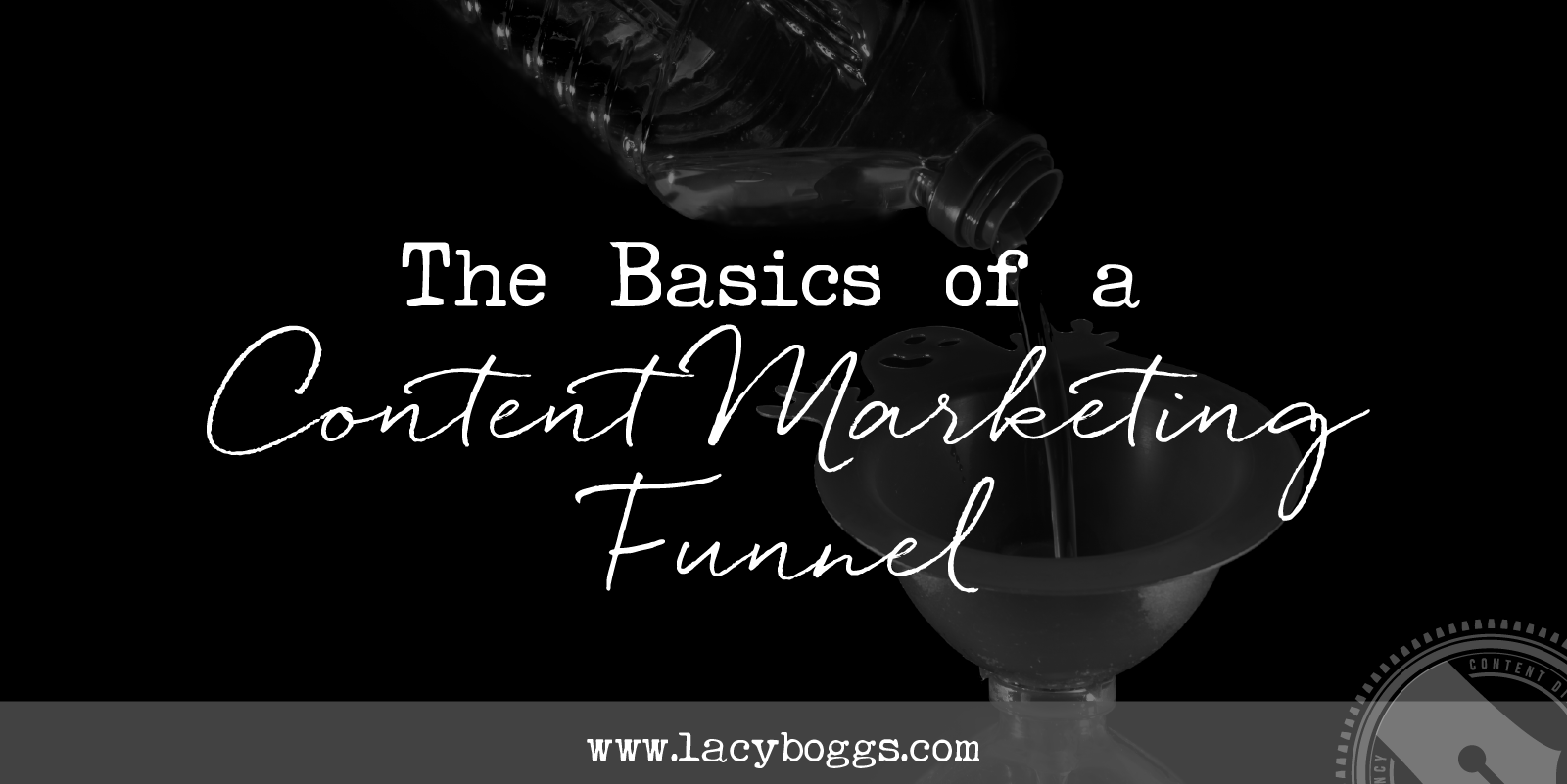If you’ve spent ANY time in online marketing circles, you’ve heard of a marketing “funnel.”
But most online marketing funnels aren’t like the funnel you might use to pour water into a jug or glitter into a little jar. For a funnel to work in real life, it has to be solid — but online marketing funnels are full of holes!
Whenever I have the “numbers conversation” with a client, we talk about how you might only get 1 percent of the total people that see your offer to buy. That’s considered average. So if you’re pouring 1,000 people into the top of your marketing funnel, 990 of those people are going to “leak” out somewhere.
That’s nuts! If we were talking about pouring water, that would be the WORST FUNNEL EVER!
But in online marketing, we just accept it as truth.
Now, before I go any further, I don’t want to insinuate that I can give you a water- and customer-tight marketing funnel. It just doesn’t work like that. You’d be the best sales person on the PLANET if you got all 1,000 people who saw your offer to buy it.
But I do think we can improve on those numbers a bit and plug a few holes in our so-called funnel with some thoughtful planning and consideration.
What does a good content marketing funnel actually look like?
The other thing about online marketing funnels is that a lot of people think that a funnel has to be complicated. I think that’s because some business coaches want you to think they’re complicated — with upsells, downsells, crossells, etc. — because then you need more coaching, right? 😉
But really, an online marketing funnel doesn’t have to be complicated at all. What it does have to be is effective in moving your ideal customer toward a sale. And it needs exactly as many steps and pieces of content as necessary to do that job — no more, no less.
Simple! Not easy.
A basic content marketing funnel might look like this:
- Content that attracts new people
- A reason for those new people to opt-in to your email list
- One or more emails to prepare people for a sale
- A sales page or other way to communicate your offer
THE END.
Of course you could add a lot more bells and whistles, and the way you execute each step might vary, but that’s the basics. And, honestly, adding more stuff does not guarantee that you will have a better outcome.
What does guarantee a better outcome is considering how to use content strategically at each step to plug some of those holes and move as many people forward toward a sale as possible.
Let’s talk a little about each step.
Step 1: Attract new people with content
This is your most outward facing content, and it could include:
- blog posts
- podcast
- social media posts
- live video
- advertising
- interviews
- guest posts
- etc.
The most important part of this step to remember is that the goal of this kind of content is to attract new people — not just preach to the choir (ie: your existing raving fans). The topics that you choose for this content should directly relate to the sale you eventually want to make — even if you need to move your audience along the customer awareness spectrum a few steps before they get there.
Need a refresher on the customer awareness spectrum?

The entire purpose of a funnel is to move people along this awareness spectrum — because if everybody came to you ready to buy, you wouldn’t need a funnel.
So, in order to determine what types of content you need to create, you need to ask yourself what stage you’re going to be speaking to at any given time. How do you know which stage to speak to?
- If you are offering something new or just getting started, you want to speak to people who are Solution Aware or Aware of You. These are your early adopters. They already know they want what you’re selling, you just have to give them the details and help them say yes.
- If you’ve presented an offer a few times, you may want to move back and start addressing people who are Problem Aware. You can actually stay in this stage for quite a while if your product or service is a solution to many different problems (or many variations of the same problem).
- If you’ve been in business for a while OR you’re bringing in a lot of new traffic that aren’t super familiar with your or what you do, you’ll want your content to speak to the Unaware audience.
Advertising is almost always directed at an Unaware audience or, at best, a problem aware audience. Guest posts and podcast interviews are also often aimed at an Unaware audience simply by virtue of the fact that you’re coming to talk to someone else’s audience. Your own social media networks, blog readers, podcast subscribers, and email subscribers will be further along the spectrum.
In general, the further away you get from the sale on the customer awareness spectrum, the more education you need to do through content before you ask for the sale. You can try to move people along the spectrum through blogging alone — but it’s much safer to try to capture their email address and continue education through email, so that they’re more likely to see it.
Step 2: Win their email address with an opt-in offer
This step is assuming that you do the majority of your educating/selling through email. There are exceptions to this rule! If people just get on a call with you to buy your thing, you might be able to direct them there right from a blog post — or you might want to educate and qualify them more through email before you invite them onto a call.
In general, though, most businesses can benefit from growing an email list and using that list to speak to their customers.
How do you decide what to offer for an email opt-in offer? Consider what the customer needs to know/do to move to the next stage of awareness.
If your content is speaking to the Unaware audience, you don’t want a lead magnet that’s directed at Solution Aware people; you want a download that will help them move from Unaware to Problem Aware.
NOTE: This is one place I often see people fumble with their marketing funnel because their lead magnet doesn’t directly connect the audience they’re speaking to and the next step in the spectrum.
Step 3: Email content to prepare people for a sale
The types of content you need to create next will depend on the decisions you made in the previous steps. You will need more content and more education the earlier in the awareness spectrum you’re pulling people into the funnel.
If your outward facing content (step 1) is aimed at the Unaware reader, and your lead magnet helps them become Problem Aware, then your email content is responsible for moving them to being Solution Aware, and Aware of You (and ready to buy). That’s going to be more content than if you’re attracting Solution Aware people and just need to help them to say yes to your offer.
How many emails do you need in your funnel? I can’t answer that for you! 🙂 This is a place where you need to test how much information, how much education, how much help they need overcoming objections before they’re ready to buy.
The answer to “what” and “how much” varies; but this is a place I see many business owners not paying enough attention to how they’re using their email to prepare people to take the next step. This is also a great place to engage an expert for help, because she can make the process of determining what and how much education is needed much faster and more efficient.
What’s awesome about this, though, is that once you figure it out, you can automate this completely (until your funnel changes).
Step 4: Make the offer
Your final piece of content in this simple funnel is to make the offer. You can do this through a combination of any of the following:
- webinar
- social media
- live video
- pre-recorded video
- sales page
- etc.
You might do one of these, you might do all of them. Again, your mileage may vary. But you must have at least one of them to convey an opportunity and an offer. And studies show that the more ways and more times you promote that opportunity, the more sales you will make.
But don’t let the perfect be the enemy of the good; if you have a new offer and you’re speaking to Solution Aware folx, you may only need a couple of great emails with strong calls to action to make your offer. If you’ve been working to educate and warm up Unaware people all the way through the awareness spectrum, you may need and want more opportunities to continue to move them toward a sale, like a webinar, a sales page, and a full email sales sequence.
This is another place I would encourage you to experiment with how little you can do to get the number of yesses you want. All the funnel templates and coaches and experts out there seem to suggest you need more of everything, but I’m fascinated by the business owners I see trimming down their sales process to absolute basics — and having their best sales ever.
As long as you have these four steps covered — in some form or fashion — you have a content marketing funnel.
Remember: Better funnels are not built with more stuff but rather are built through better strategy about how each piece of content will lead to the next. Let’s work smarter, not harder, to build better content marketing funnels.


Excelent articule
Thanks Jorge!
Lacy,
You are on the money. I love that you were not afraid to chose simplicity (4 steps) not real need for 17 e-mails.
Tommy
Thanks Tommy!